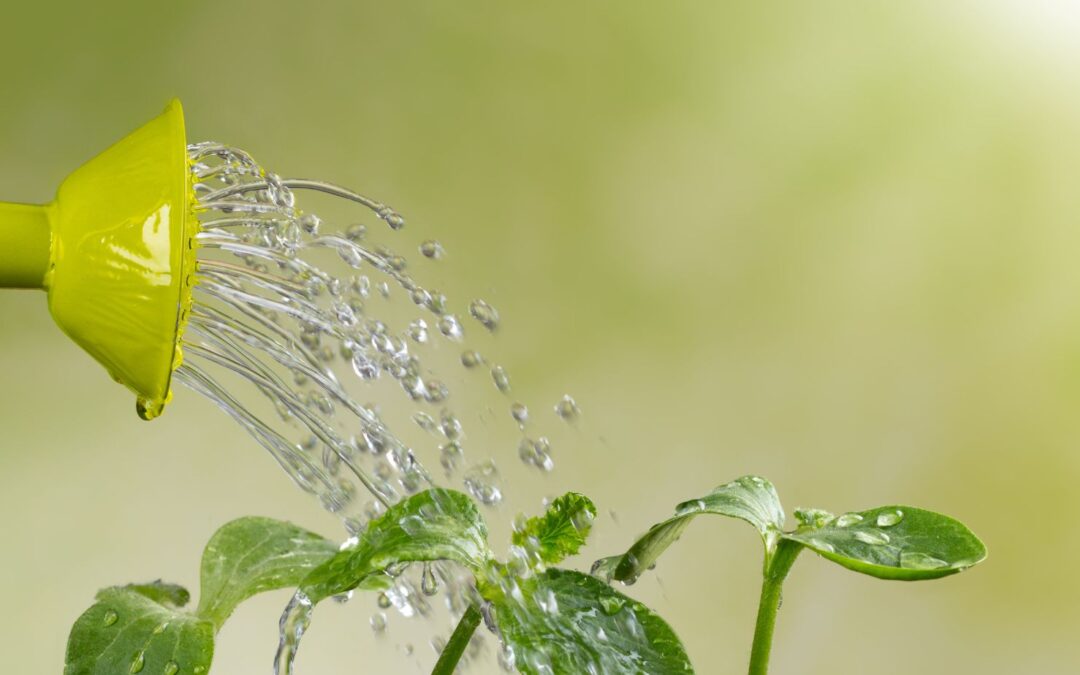Maintaining a thriving garden includes more than just planting and pruning—it requires studying the artwork of watering. Neglecting this critical component can cause a lacklustre increase, wilting foliage, or even plant dying. To assist you in steering clear of common pitfalls, we’ve teamed up with gardening professionals to find the cardinal sins of garden watering and how to avoid them.
The Garden Watering Mistakes to Avoid
Drawing suggestions from RHS watering guidance, we’ve collaborated with gardening experts to compile a comprehensive listing of watering errors that could sabotage your gardening efforts.
Harnessing rainwater is an overlooked possibility for sustainable gardening, according to Catherine Capon, a flora and fauna professional. Failing to include rain harvesting now not only squanders a valuable resource but also jeopardises plant health. Consider those tips to maximize rainwater series:
- Invest in Rain Barrels: Install rain barrels or water butts to capture rainwater out of your roof and gutters for later use in watering your garden.
- Water Efficiency: Practice water-efficient gardening techniques to minimize water wastage and conserve this treasured resource.
- Wildlife Preservation: Conserving rainwater benefits local flora and fauna by keeping herbal water resources and maintaining biodiversity.
Position rain barrels strategically to acquire runoff from downspouts and roof edges effectively.
Use rainwater for watering outside plant life, washing out of doors and surfaces, and topping up ornamental water functions.
Watering throughout the Hottest Part of the Day
Timing is crucial when it comes to watering your lawn, cautions James Brooks, foodie and avid gardener. Watering at some point during high sunlight hours can cause inefficient water absorption and capability harm to plant life. Instead, adhere to the subsequent watering timetable:
- Morning or Evening: Water vegetation all through the cooler morning or night hours to optimise water uptake and minimise evaporation.
- Deep Watering: Ensure thorough watering with the aid of allowing droplets enough time to permeate the soil and attain plant roots for top-quality hydration.
Consider investing in a drip irrigation system or soaker hoses to deliver water directly to the root sector, decreasing water loss due to evaporation.
Install a timer for your irrigation machine to automate watering schedules, making sure regular moisture degrees in your vegetation.
Overwatering
While it is tempting to bathe your flowers with extra water, over-watering can spell catastrophe in your garden, warns Andrew O’Donoghue, co-director at Gardens Revived. Guard in opposition to overzealous watering with those preventive measures:
– Monitor Soil Moisture: Check soil moisture stages frequently using a moisture meter or your fingertip to gauge watering desires as they should be.

– Deep Root Establishment: Encourage deep root increase with the aid of watering from time to time, however deeply, selling plant resilience and nutrient absorption.
– Additional Tips: Allow the soil to dry out barely among watering classes to save you waterlogged conditions and root suffocation. Use well-draining potting mixes and containers with drainage holes to save your water from accumulating round plant roots.
Underwatering
Underestimating your flowers’ water necessities can be just as detrimental as over-watering. Avoid parched vegetation by adhering to these watering guidelines.
Assess soil moisture stages earlier than watering, adjusting frequency and extent in step with every plant’s unique needs. Choose pots with good enough drainage to save your water logging and ensure the right aeration for wholesome root development.
Group plant life with comparable water requirements together to streamline watering exercises and save you over or beneath-watering. Incorporate water-preserving amendments, which include perlite or vermiculite, into the soil to improve moisture retention and sell healthy plant growth.
Failing to Mulch
Uncovered soil is a recipe for disaster in anylawn, asserts James. Mulching not only conserves soil moisture but also enriches soil fitness and suppresses weeds. Embrace the advantages of mulching with those hints.
Opt for organic mulches, including compost, straw, or grass clippings, to nourish soil and aid useful microorganisms. Apply a generous layer of mulch around flora to hold soil moisture, lessen evaporation, and minimize weed increase.
Apply mulch to an intensity of 2-four inches of round vegetation, leaving a gap around the base to save your moisture-associated problems, including stem rot.
Refresh mulch annually to refill vitamins and hold its effectiveness in protecting soil moisture.
Inconsistent Watering Schedule
Establishing a steady watering habit is prime to maintaining wholesome flowers in the course of the developing season. Without a regular watering schedule, plant life may additionally revel in fluctuations in soil moisture degrees, leading to pressure and diminished increase. To ensure certain most desirable hydration in your garden, recall the following tips:
- Establish a Watering Routine: Set an ordinary watering timetable that aligns together with your day recurring, making it easier to hold regular moisture tiers on your flora.
- Utilise Reminders: Use a calendar or reminder machine to live on target with watering schedules, adjusting frequency as needed primarily based on weather conditions and plant necessities.
Newly planted specimens require more care and interest to help them establish strong root structures and adapt to their new surroundings. Neglecting to water newly planted plant life can bring about transplant shock and avert their growth. Follow these guidelines to ensure the success of your newly planted specimens:
- Immediate Watering: Water newly planted specimens straight away after planting to lessen transplant shock and promote root-established order.
- Monitor Soil Moisture: Keep a close eye on soil moisture degrees inside the days following planting, imparting supplemental water as needed to support plant survival and increase.
Proper watering technique is critical to make sure that water reaches the basis zone wherein flowers can take in it effectively. Neglecting to water the base of plants and rather watering foliage can boost the threat of fungal infections and foliar diseases. To prevent such troubles, keep in mind the following suggestions.
Direct water to the bottom of plants instead of spraying foliage to minimize the chance of fungal infections and foliar illnesses. Utilise watering cans or drip irrigation systems to deliver targeted water utility, ensuring ultimate hydration for plant roots.
Thinking Every Plant Needs the Same
Each plant species has precise water requirements primarily based on factors including its local habitat, growth stage, and environmental conditions. Assuming that each plant calls for an equal amount of water can cause over or under-watering, compromising plant fitness. To tailor your watering practices to satisfy the individual desires of every plant and ensure optimal growth, consider seeking professional gardening services.

Familiarise yourself with the particular water requirements of every plant species for your garden, adjusting watering practices accordingly. Group plant life with comparable water needs together to simplify watering workouts and make sure that each plant gets the best quantity of moisture.
Forgetting Plants in Module Trays
Seedlings and younger flora housed in module trays are mainly at risk of dehydration, specifically in warm climate conditions. Neglecting to water module trays regularly can hinder seedling boom and delay plant improvement. To save you from moisture-related problems, follow these hints:
Monitor soil moisture stages regularly in module trays, as they tend to dry out fast, particularly in warm climates. Water module trays should be used each day or as had to save you from dehydration and ensure a wholesome seedling boom.
Failing to Check the Water Pressure
Adjusting water stress settings is crucial to make certain that flowers receive an adequate and gentle waft of water all through watering periods. Failure to test water pressure can damage flora and cause inefficient water distribution. To optimise water shipping and minimise plant strain, consider seeking professional gardening services. Additionally, consider the subsequent guidelines:
Adjust water strain settings on hoses or irrigation systems to supply a gentle, even flow of water that may not harm plants. Utilize watering attachments with adjustable settings to govern water pressure and tailor watering to the precise needs of flowers.
Forgetting to Feed as You Go
Incorporating fertilisers into your watering routine is essential for providing plant life with critical vitamins and promoting wholesome increase and flowering. Neglecting to feed vegetation as you water can bring about nutrient deficiencies and faded plant health. To maximise the benefits of fertiliser software, recall the subsequent suggestions.
Incorporate liquid fertilisers into your watering recurring to provide vital vitamins to plants with each watering session. Dilute liquid fertilisers in line with bundle instructions and apply them at once to the soil’s round flowers to sell sturdy increase and flowering.
Conclusion
By heading off these commonplace garden watering mistakes and implementing best practices, you could ensure the health and power of your garden. Remember to tailor your watering routine to fulfil the particular wishes of every plant, monitor soil moisture tiers diligently, and utilise rainwater harvesting strategies every time feasible. Additionally, for those who may require extra assistance or expertise in maintaining their garden, seeking professional gardening services can be immensely beneficial.
Jessica has a flair for writing engaging blogs and articles. She enjoys reading and learning new things which enables her to write different topics and fields with ease. She also strives to break down complex concepts and make them easy for anybody to comprehend.





